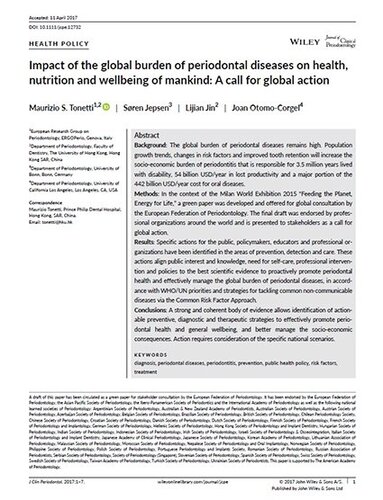![]()
22 May 2017
Leading researchers call for global action on prevention, diagnosis, and treatment of periodontal disease
Categories:Communication, Science

A call for global action to reduce the impact of the burden of periodontal diseases on health and well-being has been issued in a health-policy paper published this month in the Journal of Clinical Periodontology (JCP), the EFP’s scientific journal.
The paper – “Impact of the global burden of periodontal diseases on health, nutrition and wellbeing of mankind: A call for global action” – was written by four international experts including JCP editor Maurizio Tonetti and EFP past president Søren Jepsen.
It is the final version of the “Perio Focus green paper” that was issued in January 2016 and circulated for stakeholder consultation by the EFP.
Thanks to that consultation, the paper has been endorsed by the EFP, the Asian Pacific Society of Periodontology, the Ibero-Panamerican Society of Periodontics, the International Academy of Periodontology, and 46 national societies of periodontology (including 29 of the 30 EFP-affiliated societies). It is also supported by the American Academy of Periodontology.
The paper notes that the global burden of periodontal diseases remains high, having increased by 57.3% between 1990 and 2010, largely as a consequence of a growing ageing population and increased tooth retention. Severe periodontitis is the sixth most prevalent disease worldwide, with an overall prevalence of 11.2%, affecting about 743 million people.
Overall, periodontitis is responsible for 3.5 million years lived with disability, costs US$54 billion (€50 billion) per year in lost productivity, and represents a major portion of the annual cost of US$442 billion (€407 billion) of oral diseases.
It is in this context that the paper’s authors propose specific actions in the areas of prevention, detection, and treatment as a way to promote periodontal health and manage the global burden of periodontal diseases.
Prevention
Prevention is key to oral health, says the paper, and periodontitis can be prevented through the effective management of gingivitis and the promotion of healthy lifestyles.
Two elements are necessary to achieve these objectives: professional instruction in self-performed oral hygiene (such as tooth-brushing and inter-dental cleaning) and an integrated and population-based approach to health education based on the Common Risk Factor Approach, which is strongly advocated by the World Health Organization (WHO).
“A critical element is that prevention should be tailored to individual needs through diagnosis and risk profiling,” note the authors, who endorse the package of prevention measures advocated by the 2014 European Workshop on Periodontology on the effective prevention of periodontal and peri-implant diseases.
Diagnosis
Noting that periodontitis can be “easily diagnosed” via a comprehensive full-mouth periodontal evaluation, the paper says that periodontal probing should be a “key component” of the regular dental visit.
The authors point out that professional approaches to periodontal screening that are both sensitive and inexpensive were introduced more than a quarter of a century ago. Nonetheless, “their routine adoption by all oral healthcare professions has been an elusive objective, and the burden of undiagnosed disease remains high worldwide.”
A three-step approach to periodontal diagnosis is advocated:
(1) patient self-detection of the symptoms and signs of periodontal disease;
(2) professional periodontal screening to segment the population into three groups – periodontal health, gingivitis (to plan care to prevent periodontitis), and periodontitis;
(3) comprehensive periodontal examination and diagnosis to plan appropriate treatment of periodontitis.
Treatment
The paper notes that there is “overwhelming evidence” that periodontitis can be treated and effectively managed in the majority of cases.
Treatment aims to control gingivitis and periodontitis, to avoid disease progression that leads to tooth loss, to retain functional dentition for life, to preserve self-esteem, and to improve quality of life.
In this context, and noting that the “science supporting periodontal treatment is strong”, the paper lists 14 specific actions that should be taken at the national level in order to improve access to available care by enhancing both public and professional awareness.
Conclusions
The paper notes that periodontitis can be “prevented, easily diagnosed and successfully treated and controlled following appropriate professional care and long-term secondary prevention.”
However, “various cultural and socio-economic barriers to professional care prevent the public from applying correct preventive approaches, receiving early diagnosis and seeking treatment, resulting in limited progress in improving periodontal health.”
The paper concludes that “a strong and coherent body of evidence allows identification of actionable preventive, diagnostic and therapeutic strategies to effectively promote periodontal health and general well-being, and better manage the socio-economic consequences.”
The paper “Impact of the global burden of periodontal diseases on health, nutrition and wellbeing of mankind: A call for global action” was written by Maurizio Tonetti (European Research Group on Periodontology, ERGOPerio, Genova, Italy and Department of Periodontology, Faculty of Dentistry, The University of Hong Kong), Søren Jepsen (Department of Periodontology, University of Bonn, Germany), Lijian Jin (Department of Periodontology, Faculty of Dentistry, The University of Hong Kong), and Joan Otomo-Corgel (Department of Periodontology, University ofCalifornia Los Angeles, USA).
It is published by the Journal of Clinical Periodontology as an open-access document: Tonetti MS, Jepsen S, Jin L, Otomo-Corgel J. Impact of the global burden of periodontal diseases on health, nutrition and wellbeing of mankind: A call for global action. J Clin Periodontol. 2017;00:1–7. https://doi.org/10.1111/jcpe.12732.




